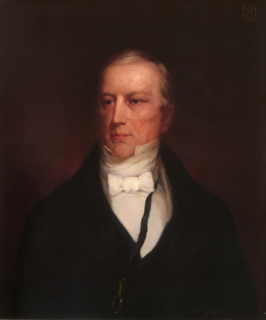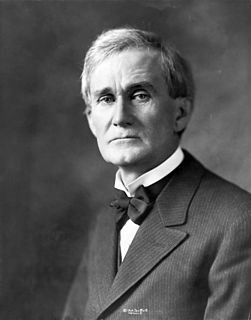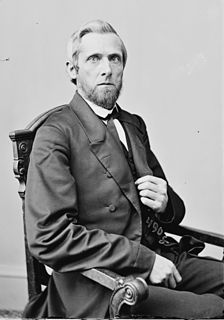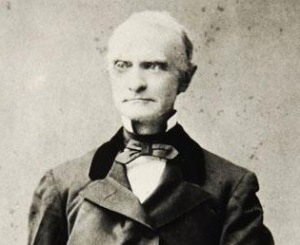
John Pope was a United States Senator from Kentucky, a member of the United States House of Representatives from Kentucky, Secretary of State of Kentucky, and the third Governor of Arkansas Territory.

Matthew Stanley "Matt" Quay was an American attorney, military officer, and Republican politician who represented Pennsylvania in the United States Senate from 1887 until 1899 and again from 1901 until his death. Quay's control of the autocratic Pennsylvania Republican political machine made him one of the most powerful and influential politicians in the country. He was influential in the 1888 election of Benjamin Harrison as President of the United States and the 1900 election of Theodore Roosevelt as Vice President. He served as chairman of the Republican National Committee during Harrison's presidential administration.

William Alexander Graham was a United States Senator from North Carolina from 1840 to 1843, a Senator later in the Confederate States Senate from 1864 to 1865, the 30th Governor of North Carolina from 1845 to 1849 and U.S. Secretary of the Navy from 1850 to 1852, under President Millard Fillmore. He was the Whig Party nominee for vice-president in 1852 on a ticket with General Winfield Scott.

Shelby Moore Cullom was a U.S. political figure, serving in various offices, including the United States House of Representatives, the United States Senate and the 17th Governor of Illinois.

Andrew Stevenson was a Democratic politician in the United States. He served in the United States House of Representatives representing Virginia, as Speaker of the House, and as Minister to the United Kingdom.

John Riley Tanner was the 21st Governor of Illinois, from 1897 until 1901.

John Marshall Hamilton was the 18th Governor of Illinois, serving from 1883 to 1885. Born in Union County, Ohio, Hamilton became interested in politics at a young age, joining the Wide Awakes when he was thirteen and the Union Army four years later. After graduating from Ohio Wesleyan University he studied law and was admitted to the bar. A notable attorney in Bloomington, Illinois, Hamilton was elected to the Illinois Senate in 1876. He served there until 1881, when he was elected Lieutenant Governor of Illinois on a ticket with Shelby Moore Cullom. When Cullom resigned after election to the United States Senate, Hamilton became Governor of Illinois. He was not selected as a candidate for re-election, but did serve that year as a delegate to the 1884 Republican National Convention. He spent the rest of his life as an attorney in Chicago, where he died in 1905.

Lincoln Home National Historic Site preserves the Springfield, Illinois home and related historic district where Abraham Lincoln lived from 1844 to 1861, before becoming the 16th president of the United States. The presidential memorial includes the four blocks surrounding the home and a visitor center.

Lawrence Yates Sherman was a Republican politician from the State of Illinois. He served as United States Senator, the 28th Lieutenant Governor, and as Speaker of the Illinois House of Representatives.

Dr. Joshua Clayton was an American physician and politician from Mt. Pleasant in Pencader Hundred, New Castle County, Delaware. He was an officer of the Continental Army in the American Revolution, and a member of the Federalist Party, who served in the Delaware General Assembly, as Governor of Delaware and as U.S. Senator from Delaware.

Waitman Thomas Willey was an American lawyer and politician from Morgantown, West Virginia. One of the founders of the state of West Virginia during the American Civil War, he served in the United States Senate representing first the Restored Government of Virginia and became one of the new state of West Virginia's first two Senators. He is one of only two people in U.S. History to represent more than one state in the U.S. Senate, the other being James Shields.

In the 1912 and 1913 United States Senate elections, Democrats gained control of the Senate from the Republicans. Of the 32 seats up for election, 17 were won by Democrats, thereby gaining 4 seats from the Republicans. Two seats were unfilled by state legislators who failed to elect a new senator on time. They were the last Senate elections held before ratification of the 17th Amendment, which established direct elections for all seats in the Senate.

The Ruben M. Benjamin House is a house in Bloomington, Illinois. It is a two-story rectangular building, styled in the Classical Revival architectural motif. It was built in 1856 John L. Routt, who would become the first governor of Colorado. Ruben M. Benjamin, an attorney known for litigation relating to railroad regulation, lived in the home for more than 60 years. The United States National Register of Historic Places added the Ruben M. Benjamin House in August 1978.

The Stevenson House, located at 1316 E. Washington St. in Bloomington, Illinois, was the boyhood home of Illinois governor and two-time Democratic presidential nominee Adlai Stevenson II. Architect Arthur Pillsbury designed the house in 1900 for original owner Lyman Graham. In 1906, six years after Adlai's birth, the Stevenson family bought the house. Adlai lived in the house through his junior year in high school to attend University High School in nearby Normal, Illinois; he subsequently graduated from the Choate School in Connecticut. He served as governor of Illinois from 1949 to 1953, ran for president on the Democratic ticket in 1952 and 1956, and served as U.S. Ambassador to the United Nations from 1961 until his death in 1965.

Major General John A. Logan, also known as the General John A. Logan Monument and Logan Circle Monument, is an equestrian statue in Washington, D.C. that honors politician and Civil War general John A. Logan. The monument is sited in the center of Logan Circle, a traffic circle and public park in the Logan Circle neighborhood. The statue was sculpted by artist Franklin Simmons, whose other prominent works include the Peace Monument and statues in the National Statuary Hall Collection. The architect of the statue base was Richard Morris Hunt, designer of prominent buildings including the Metropolitan Museum of Art in New York City and The Breakers in Newport, Rhode Island. Prominent attendees at the dedication ceremony in 1901 included President William McKinley, members of his cabinet, Senator Chauncey Depew, Senator Shelby Moore Cullom, and General Grenville M. Dodge.

Asahel Gridley was an American politician, lawyer, merchant, and banker. Born in New York, Gridley moved to Bloomington, Illinois, when he was twenty-one. He served as a brigadier general in the Black Hawk War and was elected to three terms in the Illinois General Assembly. There, he lobbied to have the Illinois Central and Chicago and Alton Railroads pass near Bloomington. Abraham Lincoln once defended Gridley during a slander trial and was a frequent collaborator or opponent in the courts. Gridley is also the namesake of Gridley, Illinois, and platted two other McLean County towns.

The Sylvester Millard House is a historic log house in Highland Park, Illinois, United States. Built in 1893 for a Chicago lawyer, the house was designed by William W. Boyington and remained in the family until the 1990s.
Jesse Kilgore Dubois was an American politician from Illinois. The son of a prominent early Illinois citizen, Dubois was elected to the Illinois House of Representatives while he was attending Indiana College. Nicknamed Uncle Jesse, he served four two-year terms there. An early Republican, Dubois was named the party's first candidate for Auditor of Public Accounts. He was elected in 1856 and served two four-year terms. He was the father of Senator Fred Dubois.

Two United States Senate elections were held in Illinois on March 26, 1913. The two elections were interconnected through a compromise made to elect a Democrat in the regular election and a Republican in the special election.




















